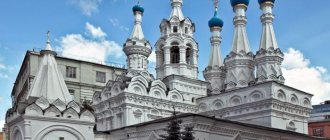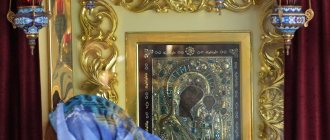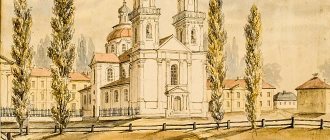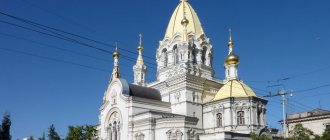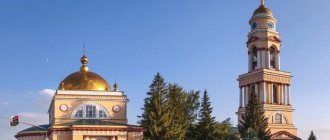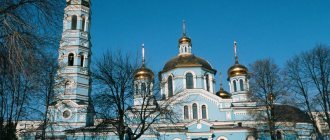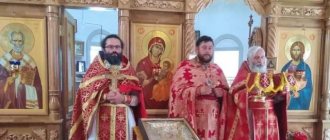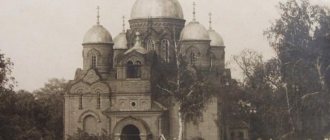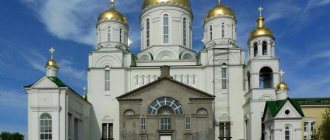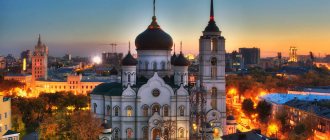Rostov-on-Don was founded to protect the southern borders of our country more than 265 years ago. Its historical and cultural attractions annually attract thousands of tourists to the city, including from foreign countries. Among them there are objects that are a must-see. For example, the majestic Cathedral of the Nativity of the Blessed Virgin Mary (Stanislavsky Street).
Rostov-on-Don is proud of this building, which is extremely similar to the Cathedral of Christ the Savior (Moscow), so its image adorns almost all tourist avenues.
History (before desecration)
In 1795, the mayor M.P. Naumov turned to Metropolitan Gabriel with a request for permission to build a stone church. The petition was granted, and soon the city center was decorated with a new stone Cathedral of the Nativity of the Blessed Virgin Mary.
Rostov-on-Don eventually became one of the economic centers of the region. It was actively built up and decorated. In 1854, it was decided to build a new Cathedral of the Nativity of the Blessed Virgin Mary instead of the dilapidated church with wooden domes. Rostov-on-Don was decorated with a building designed by the famous architect K. Ton. That is why modern tourists are always struck by its external resemblance to the exterior and silhouette of the capital’s Cathedral of Christ the Savior, created by the same author.
History[edit]
The Rostov Cathedral of the Nativity of the Blessed Virgin Mary was built in just six years and consecrated on the Nativity of the Blessed Virgin Mary in 1860.
The history of the Rostov Cathedral is amazing, and inextricably linked with the history of the city itself. It originates from a fortress in honor of St. Demetrius of Rostov, established by the highest decree of Empress Elizabeth Petrovna in 1761 on the southern borders of Russia. During the construction of the fortress on the right bank of the Don, construction immediately began on a church in the name of the Intercession of the Mother of God and a chapel in the name of the Nativity of the Blessed Virgin Mary, which was consecrated in 1761.
Soon this chapel becomes a temple. In 1781, the wooden Church of the Nativity of the Virgin Mary was dismantled and moved to the city's market square, that is, to its current location. It did not last long - just over 10 years, and burned down in a fire. In 1795, God-fearing Rostovites built a new one on the site of the burnt church - stone, with wooden domes.
By the middle of the 19th century, the Church of the Nativity of the Virgin Mary on the market square could no longer accommodate the believing people. And then two Rostov merchants Semyon Koshkin and Fyodor Nefedov, with the consent of the City Duma and with the blessing of the ruling bishop, turned to the Holy Synod at the beginning of 1854 with a request for permission to build a large cathedral at the expense of their personal funds. They also asked to provide a corresponding architectural design for the future main temple of the city.
The answer with permission came from the Synod very quickly, and it was accompanied by a project designated as a standard one for the construction of Orthodox churches taking into account the new times. The author of the project was academician of architecture Konstantin Andreevich Ton.
Next to the cathedral, on its western side, a four-tier bell tower 75 meters high was erected. Its construction was financed by another Rostov merchant, P.R. Maksimov. The good news of its 10-ton bell was heard 42 versts along the Zadon region. The birthday of the bell tower of the Rostov Cathedral is for the celebration of the Kazan Icon of the Mother of God on November 4 (according to New Age).
In front of the cathedral, on its northern side, there was a spacious square where city holidays, parades, and folk festivals took place. A monument to Emperor Alexander II was erected in the middle of the square.
The decoration of the Rostov Cathedral were large marble porches, facing: from the north side - onto Cathedral Square, and from the south - onto the shopping area, from where the main entrance was located. From this side, the faithful people came to the cathedral, coming to services from neighboring villages, from Zadonye on various river vessels and fishing boats, and they ascended from the embankment of the Don River directly to the shopping square along Soborny Lane, and the street in front of the shopping square was called Rozhdestvenskaya, after named after the cathedral.
After the revolutionary events of 1917, terrible years of godlessness and persecution of the church began. The attack on the Rostov Cathedral began back in the 20s. Then the cathedral, together with the bell tower, was surrounded by a brick fence, and the marble porches were dismantled; the only entrance to the cathedral was allowed from the western side.
In 1929, workers removed the last icon in the cathedral.
From 1932 to 1942, the cathedral was completely closed, the crosses were removed from the domes, the iconostasis and all the interior decoration were lost. A grain warehouse was built inside the temple, and a menagerie was placed in the courtyard. Eyewitnesses said that the cage with the lioness in labor was placed in the temple so that she would not frighten the people with her roar, but she began to roar even more and rushed around the cage until she was taken out into the courtyard.
At the end of July 1942, believers themselves opened the cathedral. At the beginning of 1951, the main four-tiered iconostasis was installed, made in Moscow according to the design of the iconostasis of the Cathedral of Christ the Savior. It had an unusual shape - in the form of a chapel, topped with a dome with a cross. In 1955, the same iconostases were built in the right - Petro-Pavlovsky and left - Preobrazhensky aisles. The paintings of the walls, pylons and vaults were done by the artist K. Volkov.
A new page in the history of the Rostov Cathedral begins in the late 80s. For the 1000th anniversary of the Baptism of Rus', its five domes were covered with copper and gilded, and gilded crosses shone above them.
By 1999, the bell tower was completely restored. It was consecrated during a visit to the diocese by His Holiness Patriarch Alexy II of Moscow and All Rus'.
Revival of the cathedral
In 1937, a decision was made to close the temple. The Soviet government did not find anything better than to place a zoo on the territory of the cathedral. A little later, they began to use it as a warehouse, and at the beginning of the Second World War, the upper tiers of the bell tower were dismantled, as they were afraid that the enemy would use this structure as a reference point during air raids.
In the mid-summer of 1942, during the occupation of the city, believers themselves opened the Cathedral of the Nativity of the Blessed Virgin Mary and began holding services there. Nine years later, a main iconostasis with four tiers was installed in the temple. It was made in the capital according to sketches of the altar partition of the blown-up Cathedral of Christ the Savior.
By 1999, the bell tower of the cathedral was completely restored, the consecration of which was attended by His Holiness Patriarch Alexy II himself.
History of the temple
Soon after the settlement of Soldatskaya Sloboda, a decision was made to dismantle and move the wooden church in the name of the Nativity of the Virgin Mary, erected within the boundaries of the Rostov fortress, established in 1761 by Empress Elizabeth Petrovna. The building was quickly moved to a new location next to the shopping area. In February 1781, the temple was founded, and six months later it was consecrated.
Main facade, © Valeria Belousova
The building stood for just over ten years until it was struck by lightning during a thunderstorm. The fire occurred on December 27, 1791, but after four years a new Church of the Nativity of the Blessed Virgin Mary with stone walls and wooden domes was erected here.
The church received the status of a cathedral in 1822 according to the decree of the Holy Synod. Before that she was a merchant.
The city grew rapidly, so by the middle of the 19th century the cathedral could no longer accommodate believers. Two Rostov merchants, with the blessing of the bishop, turned to the Holy Synod for permission to build a new, more spacious and majestic church. At the same time, they pledged to bear all current expenses.
The stone building was erected between 1854 and 1860. Immediately after completion of construction, the cathedral was consecrated. In 1887, a four-tier bell tower was built next to it.
Golden domes, ©
After 1917, the Rostov Cathedral suffered the fate of most religious sites of that time. Attacks on him began already in the 20s of the last century. Then the majestic marble porches were dismantled, the territory was surrounded by a brick fence, and the looting of church utensils became commonplace. The last icon was removed in 1929, and in 1932 religious services were finally banned. The church was closed, a grain warehouse was organized inside, and a zoo was set up in the courtyard. The upper part of the bell tower was half destroyed in the early forties, as it was considered an excellent landmark for enemy artillery.
The Cathedral of the Nativity of the Blessed Virgin Mary opened its doors to parishioners during the years of German occupation. Five years after the end of the Second World War, repairs were made and the wall paintings were partially restored. A more thorough reconstruction took place in the late 80s of the last century, and for the 250th anniversary of the city, the bell tower was restored using drawings and old photographs.
Upper tiers of the bell tower, © ALEXANDER
Description
Almost all excursions around Rostov-on-Don include a visit to the Cathedral, the Russian-Byzantine silhouette of which is considered one of the architectural symbols of the city. It has five domes, and the layout of the temple is shaped like a cross.
In the interior of the Cathedral of the Nativity of the Blessed Virgin Mary, of particular interest are the paintings of pylons, walls and vaults made by the artist K. Volkov, as well as the main iconostasis. It is made in the form of a chapel, which is crowned with a dome with a cross. The same altar partitions are located in the Peter and Paul and Preobrazhensky chapels.
For the celebrations dedicated to the millennium of the Baptism of Rus', the domes of the temple were covered with copper and gilded, and the same was done with the crosses that are visible from different parts of Rostov-on-Don.
Description and architecture
The stone building of the cathedral was erected in 1860 based on a standard design by Konstantin Ton, a talented architect who, in fact, was the creator of the Russian-Byzantine temple style. This was reflected in the external similarity of the Cathedral with other similar objects created by the architect. The most striking confirmation of this is the Cathedral of Christ the Savior in Moscow, founded in 1839, consecrated in 1883, destroyed in 1931 and rebuilt in the late 1990s.
Cathedral of the Nativity of the Blessed Virgin Mary in Rostov-on-Don, © Alexey
The assignment of the standard design of the cathedral to the location was entrusted to the architect and, as his contemporaries called him, the draftsman A. Kutepov, who had previously taken part in the design competition for the Cathedral of Christ the Savior.
Initially, the main entrance was located on the south side of the building - for the convenience of believers sailing along the Don from other villages. Rising from the embankment along Soborny Lane, they found themselves directly at the temple. Over time, the main entrance became from Cathedral Square.
In plan, the majestic structure looks like an equal-armed cross. The snow-white facade is decorated with keel-shaped zakomaras, emphasized by an azure-colored roofing covering. Five domes rise above the temple, mounted on light drums of different diameters. The central one has 12 slotted openings, matching in shape with the front windows. In the four outer drums, every second gap is tightly sealed. Perspective portals are completed by massive forged doors.
View of the cathedral and bell tower from the Central Market, © Alexey
The bell tower is located to the right of the main entrance to the cathedral. The authors of the project are military engineer A. Campioni and architect D. Lebedev. The money for the construction and ordering of the main bell was taken over by well-known Rostov philanthropists and the church elder at that time. The four tiers were originally crowned with a blue dome decorated with stars. A huge striking clock was installed under it. The middle levels were intended for bells, and in the lower tier a baptismal chapel was organized, consecrated in honor of St. Nicholas the Wonderworker.
After the restoration of the bell tower in 1999, newly cast bells were installed. Each of them bears its own name, associated with the heavenly patron - Saints Panteleimon and Sergius of Radonezh, Prince Vladimir, Archangel Michael. One of the bells is named in honor of the Nativity of the Blessed Virgin Mary.
Bells, © ALEXANDER
In the courtyard, in addition to the cathedral with a one-story porch and a bell tower with a chapel, there are a number of buildings. Among them:
- residence of the Bishop of the Rostov diocese;
- small temple of John the Baptist;
- service buildings;
- diocesan administration;
- printing house;
- spiritual and educational center;
- church shops.
Cathedral bell tower
In 1875, construction began on another city landmark to the west of the temple. According to the design of military architect-engineer A. A. Campioni and with funds from philanthropists S. N. Koshkin, P. R. Maksimov, V. I. Asmolov and I. S. Panchenko, a bell tower was erected in 1887.
It had a height of 75 m, and its architecture combined elements of Russian Renaissance and classicism. The head of the bell tower dome was made in blue and decorated with gilded stars. On its upper tier there was a clock with a quarter strike and four dials. They were visible from most of the city and many Rostovites checked their watches by them for a long time.
The middle tiers housed bells. The main one was cast in Moscow at the expense of I. Panchenko. He weighed 1,032 pounds. The bell was decorated with images of saints, the Mother of God and John the Evangelist. There is evidence that its shimmering ringing could be heard 4 dozen miles away.
In 1882, a small baptismal church in the name of St. Nicholas was built on the first tier of the bell tower.
As already mentioned, at the beginning of the war the two upper tiers of the structure were destroyed, and after 7 years it practically ceased to exist, since its lower part was dismantled.
The bell tower was restored in 1999, and today many sightseeing tours of Rostov-on-Don begin at its foot.
Revolution and its consequences
The October events and the Civil War brought many troubles to the cathedral. In 1920, a large number of expensive icons were stolen from it. Moreover, thefts were committed by both sides of the conflict.
The following year the cathedral clergy suffered from severe repression. Then famine sets in in the Volga region. In this regard, a special commission begins to confiscate church valuables. In Rostov, a similar action did not take place due to indignant parishioners who beat the delegation.
In the 1930s, the cathedral stopped accepting believers and was closed. Its grounds were first used as a menagerie and then turned into a goods warehouse.
The cathedral's bell tower was damaged during the Great Patriotic War. Its two upper tiers were blown up because they could serve as a reference point for enemy artillery and aircraft. Nevertheless, the central part of the city was still heavily damaged by shelling.
New bells
For many years the gospel did not sound over the cathedral. The situation changed at the beginning of the new century, when new bells were made. This responsible task was assigned to the Voronezh MP "Vera".
The new bells are not exact copies of those whose ringing once called Orthodox residents of Rostov-on-Don to church. They were named in honor of the heavenly patrons of the secular and spiritual leaders of the region.
Today, the Cathedral of the Nativity of the Blessed Virgin Mary (Rostov-on-Don) notifies parishioners with the ringing of bells:
- Great Martyr Panteleimon weighing 4 tons;
- Saint Prince Vladimir (2 t);
- Archangel Michael (1 volume);
- Sergius of Radonezh (0.5 t);
- Nativity of the Blessed Virgin Mary (0.25 t).
Cathedral Square in Rostov-on-Don
Not only the temple, but also the surrounding area is of interest. In front of the cathedral, between Moskovskaya and Stanislavsky streets, there is a small Cathedral Square. Its history is inextricably linked with the difficult fate of the temple.
In April 1890, grateful Rostovites erected a bronze monument to Alexander the Second there. The monument was erected according to the design of M. O. Mikeshin. In 1920, a plywood box with a red star was placed on the monument, and after a while it was completely demolished. After this, the square was empty for a long time.
Monument to St. Demetrius of Rostov
In 1999, Cathedral Square was transformed. Near the place where there once was a monument dedicated to Emperor Alexander II, a monument to St. Demetrius of Rostov was erected. The authors of the new sculpture were V. G. Belyakov and N. F. Gmyrya.
The monument was hastily erected during the celebrations dedicated to the 250th anniversary of Rostov-on-Don, at the insistence of the city administration. This decision caused a mixed reaction from the public. First of all, the reason for the dissatisfaction was the low artistic level of the monument. The Saint's vestments and the inscription on the pedestal were also criticized. Many experts pointed out that an extremely unfortunate place was chosen for the installation of this new landmark of the city. They called for the erection of a monument on the territory where the fortress was previously located, or on Stepan Shaumyan Street (previously called Dimitrievskaya).
Rostov Cathedral of the Nativity of the Blessed Virgin Mary
The current Rostov-on-Don Cathedral in honor of the Nativity of the Blessed Virgin Mary can be considered the sixth temple of the same name in the city. Its history began with a small wooden chapel built in 1766 by residents of the Eastern merchant outpost of the fortress of Demetrius of Rostov in the settlement of Poludenny Stan (Poludenke), located on the territory of the future city of Nakhichevan within the boundaries between the current 1st and 7th lines. After a short period of time, the chapel underwent reconstruction. An iconostasis is installed in the chapel, as a result of which it turns into a full-fledged church and it can be considered the second temple, which later, only after several reconstructions and transfers to new places in the city, was to become a cathedral. There is information that in 1771, due to a pestilence spreading in the region, the inhabitants of the Midday Camp wanted to build a chapel in the church in the name of the holy martyr Harlampy, who saved believers from the epidemic. The consistory proposed to build a larger church instead of the small church. But the epidemic that reached the camp not only did not slow down the planned construction, but also forced the surviving residents of the settlement to leave their homes and scatter around the area. Only after twelve years, this small temple in the same area is replaced by a wooden, but more spacious temple. However, when creating this third temple, both the soldiers and the residents did not suspect that this temple would only have to exist for one year. Already in 1780, the population of the Poludenny Stan was forced to give way to the Crimean Armenians resettled here from Crimea. The Little Russians who were in the camp were resettled “on the other side of the Don River, along the Koisug River,” and Russian soldiers, merchants and townspeople were resettled in the Soldatskaya Sloboda fortress. In the same settlement, near the current Central Market, a place was determined for the Church of the Nativity of the Blessed Virgin Mary. On February 20, 1781, Archpriest John Andreev consecrated the foundation site of the temple, and on September 5, 1781, the completed temple. But even in this place, this fourth church existed for only ten years: on December 27, 1791, the church, which by that time was called a merchant’s church, burned down from a lightning strike. The head of the local government of the nascent city, merchant Mikhail Prokofievich Naumov, petitions the Metropolitan of Ekaterinoslav Gabriel for the construction of a new church. As a result of the satisfaction of this petition, in 1795, on the site of the burnt one, the fifth stone (merchant) Church of the Nativity of the Blessed Virgin Mary was built, and in the corner of its stone fence - a small “warm” one. Church of the Three Saints. The New Nativity of the Mother of God Church in the decree of the Novorossiysk Consistory for 1800 is still called a merchant church, but already in 1822 the Holy Synod transfers it to the rank of cathedral. At the same time, it soon becomes clear that the cathedral church, due to its small size, cannot meet the needs of the rapidly growing city. Referring to the rapid increase in the population of Rostov, the headman and trustee of the temple, merchant Konstantin Mikhailov-Nefedov and merchant Semyon Nikolaevich Koshkin turn to Bishop Innocent of Yekaterinoslav and Taganrog and receive permission from the Holy Synod to build a new, more spacious cathedral. They allocated a large sum of money for the construction, the bulk of which was the contribution of the headman of the cathedral. In addition to them, the construction of the new Rostov cathedral was helped by Archpriest Grigory Sherbansky and Kozma Grigorievich Kramarenko, who were transferred here from the fortress Church of the Intercession. As a result of the activities of these individuals, in 1845 the “Case of the Highest Approval of the Project of a new stone church instead of the stone cathedral church with wooden domes that had fallen into disrepair” was completed. The new (sixth) Rostov cathedral was founded in 1854, and completed and consecrated in 1860. The cathedral was built on the former Staro-Pochtovaya Street, now it is Stanislavsky Street, 58. The main temple of Rostov gave its name to Soborny Lane (in Soviet times it was called Podbelsky Lane) and Rozhdestvenskaya Street (now it is Defense Street). The author of the cathedral project is considered to be academician of architecture, professor Konstantin Andreevich Ton (1794-1881). The direct “linking” of Tonov’s design for the Church of the Presentation of the Holy Virgin into the Temple in the Semyonovsky Regiment in St. Petersburg (a smaller version of the Cathedral of Christ the Savior in Moscow) to Rostov conditions in order to reduce the cost of construction work was carried out by the architect A.S. Kutepov. Rostov Cathedral was built in the Russian-Byzantine style (the term of our time). Before the revolution K.A. Ton was considered the creator of the Roman-Byzantine architectural style in Russia. This cruciform in plan, five-domed cathedral is distinguished by the monumentality of its forms. It immediately became an integral city-forming element of both the Old Bazaar square (the current Central Market) and the entire city center. The cathedral has a single compositional basis with the Moscow Cathedral of Christ the Savior (design by K. A. Ton), but, unlike it, is smaller in size (height to the cross 49.8 m) and more modest in the decoration of the plastered facades. All five domes of the cathedral were intended to be gilded, but due to lack of funds, they were then covered only with verdigris. The gilding of all the heads of the temple was carried out only in 1988, i.e., for the celebration of the millennium of the baptism of Rus'. In addition to the main altar in honor of the Nativity of the Blessed Virgin Mary, the cathedral has two side chapels with altars: the right one in honor of the Transfiguration of the Lord and the left one in the name of the Holy Apostles Peter and Paul. Interior of the Rostov Cathedral in the 19th century. was decorated with beautiful frescoes, made at the expense of the main trustee of the construction of the cathedral, an honorary hereditary citizen of Rostov-on-Don I.S. Panchenko. The main iconostasis was made of carved wood and gilded. Thanks to Panchenko, expensive icons appeared in the cathedral. Sixteen gilded carved icon cases were placed along the walls of the temple. The floor of the temple was skillfully covered with marble slabs. The main shrine of the pre-revolutionary Rostov cathedral was the especially revered icon of St. Demetrius, Metropolitan of Rostov. The porches were made of marble. The southern porch overlooked the shopping arcades and at that time was the main entrance to the cathedral. The northern porch overlooked the cathedral square. After the consecration of the new Rostov Cathedral, the old temple was dismantled, and for sixteen years this place was empty. In 1875, on the site of the old dismantled temple, i.e. On the western side of the erected cathedral, a four-tier bell tower was built. The bell tower project was developed by regional military architect A.A. Campioni. The architect D.V. Lebedev helped him in his work. Rostov merchant Pyotr Romanovich Maksimov donated funds for the construction of the bell tower. In addition to him, the trustees of the construction were the merchant of the Don Trading Society S.N. Koshkin and tobacco manufacturer, philanthropist V.I. Asmolov. Archpriest L. Kreshchanovsky points out that funds for the construction of the bell tower also came from the church warden, honorary citizen of the city I.S. Panchenko, Construction of the bell tower lasted twelve years: it was consecrated in 1887. The slender white stone bell tower, 75 m high, built using architectural forms of the classicism and renaissance styles, became the decoration of the square and the dominant panorama of Rostov. The blue dome of the bell tower was decorated with gilded stars. The room in the upper tier of the bell tower was intended for installing a clock. This four-dial clock with a quarter strike, which at that time cost 2899 rubles, was installed four months after the consecration of the bell tower. The middle tiers of the bell tower were intended for the installation of bells. Here on October 15, 1887, the first bells were hung, previously located on a temporary wooden structure on the ground, and a week later, on October 22, during the liturgy, a new bell weighing 1032 pounds (16.5 tons), cast at the expense of the church warden, a merchant, was consecrated I. S. Panchenko in Moscow at the N. D. Finlyandsky plant. This bell was decorated with four images: the Nativity of the Blessed Virgin Mary, the Great Martyr Panteleimon the Healer, the Iveron Icon of the Mother of God and the Holy Evangelist John the Theologian. They said that the ringing of this main bell carried across the seas over a distance of over 40 miles. In 1882, in the premises of the first lower tier of the bell tower, the so-called small baptismal church was built in the name of St. Nicholas, Archbishop of Myra in Lycia, miracle worker. Nine years after the assassination of Emperor Alexander II by the Narodnaya Volya, on April 17, 1890 (on the day dedicated to the birthday of the deceased), the solemn opening of the monument to the Tsar-Liberator took place in front of the Rostov Cathedral in the presence of the Bishop of Yekaterinoslav and Taganrog, the military ataman of the Don Army and other officials. The monument was built with private donations according to the design of the sculptor Academician M.O. Mikeshina (1835-1896). The height of the monument was ten meters, and the weight of the bronze sculpture was 250 pounds (4 tons). The inscription on the monument read: “Emperor Alexander II. Grateful citizens of Rostov-on-Don." In 1920, the “new” citizens covered up the monument with a plywood box with a red star, and four years later they completely destroyed it. The October Revolution and the Civil War marked the beginning of hard times for the cathedral. In 1920, the temple experienced great losses: many valuable icons and utensils were plundered by both the whites fleeing their homeland and the red victors. As Soviet historians wrote about the events of the Civil War, “during the retreat of the white volunteer army of General A.I. Denikin from Rostov in January 1920, her counterintelligence left over 200 White Guard officers in the city for subversive counter-revolutionary work. At the head of this gang were Prince Ukhtomsky and the rector of the Verkhovsky Cathedral.” Similar statements were used to justify repressions against clergy in Rostov. Already in the early 1920s. The abbot of the temple was asked to close the southern and northern entrances to the temple and use only the western one. Therefore, a new vestibule was added to the western entrance of the temple, topped with a small cylindrical dome drum with an onion dome and a cross. In 1921, direct repressions began against the cathedral clergy. Thus, the aforementioned Archpriest Verkhovsky is arrested in the invented case of the Russian Salvation Army. In 1922, actions began in the country to confiscate church valuables in connection with the famine in the Volga region. In Rostov, this action took place on March 11, but in the cathedral it was actually disrupted. Outraged by the commission's behavior, the parishioners beat up the commission members. As a result of this event, the first bishop of the Rostov independent diocese, Bishop of Rostov and Taganrog Arseny (Smolenets, 1873-1937), elected to the cathedral in Stavropol in 1919, seven priests, including Archpriest John Tsarinenko, the keymaster of the cathedral, and four members of the parish council were arrested and the audit commission of the cathedral. In total, 37 people appeared before the Don Revolutionary Tribunal. In the 1930s, the Rostov Cathedral was closed completely. A menagerie was first set up on its territory. Eyewitnesses of those years spoke, albeit in different versions, about the roar of a lioness giving birth there. Then the cathedral was turned into a warehouse. The cathedral has lost the crosses on the domes, iconostasis, icons, marble floor and other interior decoration. In Soviet times, there were several cases when hooligan thieves used the appearance of the bell tower for their own unseemly purposes. On clear days, the slow movement of the clouds created the illusion of the bell tower falling. At this moment, these hooligan youth shouted “The bell tower is falling!” created panic in the bazaar and stole goods from traders fleeing from fear from the shelves. Tragedy awaited the bell tower of the cathedral during the Great Patriotic War. By decision of the city committee and regional committee of the All-Union Communist Party of Bolsheviks, which led the Rostov City Defense Committee in July 1942, the upper two tiers of the bell tower were blown up, as it was assumed that it could serve as a reference point for the Germans for artillery fire and air bombing. Nevertheless, the absence of a high landmark did not prevent German pilots from destroying almost the entire central part of the city in the summer of 1942. During the second German occupation of Rostov, which lasted more than six months, a revival of church life in the city began. The occupiers did not interfere with the revival of diocesan activities. There were clergymen, such as Vyacheslav Serikov, John Nagovsky, Archbishop Nicholas of Amasia, who was dismissed from the administration of the diocese in 1937, who revived religious activity in the city. On the initiative of the archbishop, the cathedral was brought into a relatively decent state and regular services began to be held there. However, it must be assumed that the archbishop, shortly before the liberation of Rostov from the German occupation, made a rash decision to ask the Romanian patriarch to accept the Rostov diocese into his department. This act and other arbitrary decisions of Archbishop Nicholas caused an extremely negative reaction from the Moscow Patriarchate. The services that began during the German occupation did not stop even after the liberation of the city from the occupiers on February 14, 1943. These services were held simultaneously with the restoration of beauty in the temple. The wall paintings of the temple were updated by the artist Ivan Ivanovich Volkov (1887-1962), which he and the artist A. V. Podorozhnaya completed back in 1929. In 1949, the second tier of the bell tower was dismantled by German prisoners of war who were in Rostov. The lower tier was turned into an independent small baptismal church (chapel) in the name of St. Nicholas, Archbishop of Myra in Lycia, wonderworker. Unfortunately, this event in the 1990s turned out to be very inappropriate for the restoration of the bell tower, since the strength of the new bell tower is significantly inferior to its predecessor, which did not allow the use of bells of the same weight. In the mid-1950s, according to the design of Rostov architect D.F. Eberg, Moscow craftsmen restored the iconostases of the cathedral in the form of chapels. In the years 1950-1970, the cathedral courtyard was restored with great difficulty. For the holiday of the millennium of the Baptism of Rus', the domes of all the domes of the cathedral shone in gold over the city. In 1991-1992, work began to restore the bell tower to its previous form. The project for recreating the bell tower was developed by the architect Yuri Nikolaevich Solnyshkin. Unfortunately, due to financial difficulties, as well as due to the poor quality of the material, the construction of the bell tower stopped in 1996, when the financial income from the entrepreneur Adam Yasaevich Batazhev ended. Construction work resumed in 1998, when the administration sought funding from the budget funds of the city and region. Due to the late receipt of funds, construction was completed in September 1999 literally the day before the celebrations dedicated to the 250th anniversary of Rostov. On the day of the temple holiday of the Nativity of the Blessed Virgin Mary, September 21, 1999, Patriarch of Moscow and All Rus' Alexy 11 consecrated the recreated bell tower. By order of the city administration, the Voronezh small enterprise “Vera” ordered new bells for the bell tower. These new five bells do not repeat the names of the previous ones, and they are inferior in size. As attentive Rostov journalists noted in the press, the names of these new bells are consonant with the names of the clergy and civilians of the city and region involved in the bell tower being recreated, which, in general, is a common occurrence in the business of temple construction. The largest bell (4 tons) is named after the Great Martyr Panteleimon the Healer, who is the heavenly patron of the former ruler of the diocese. The next largest bell (2 tons) is dedicated to the Holy Equal-to-the-Apostles Great Prince of Kyiv Vladimir, i.e., the heavenly patron of the former governor of the region. The bell, weighing one ton, bears the name of the guardian angel of the mayor of Rostov, namely, Archangel Michael. The half-tone bell bears the name of the guardian angel of the former rector of the cathedral - St. Sergius of Radonezh. Finally, the smallest bell (0.25 t) is dedicated to the cathedral, namely the Nativity of the Blessed Virgin Mary. However, according to some experts and musicologists, not everything was optimally solved in this reconstructed bell tower. They believe that the harsh, heavy ringing of the new bells is somewhat contrary to the modern harmonious architectural forms of the Rostov bell tower. Restoration work in the interior of the first tier of the bell tower lasted 12 years: only on December 4, 2011, the restored chapel in the name of St. Nicholas, Archbishop World of Lycian, miracle worker. In 1989, the city authorities of Rostov-on-Don approved a security zone for the courtyard of the Rostov Cathedral. This decision contributed not only to the gradual improvement of the territory near the cathedral, but also to the legalization of its economic activities. Work began not only on the restoration of the destroyed bell tower, but also on the construction of new facilities. In a short time, in 1992, a small church of worship appeared in the courtyard of the cathedral, consecrated in honor of the Nativity of the venerable, glorious Prophet John the Baptist, the Baptist of the Lord. This new small temple is always crowded with believers who need church trembs (departures of the Holy Rite). It was located in the restored outbuilding of the cathedral farmstead and is allocated only by one small headquarters. A Sunday school was arranged next to him. In the same building, at first, a spiritual literature store was also stirred, which in 2000 found for himself a new room next to the courtyard of the cathedral on ul. Stanislavsky (b. Star-posted street). The Rostov Cathedral is also acquired by the new shrines-relocations in return for those lost. Of these, one can note the icon of the Holy Trinity with a particle of the Mamvrian oak, the power of the Patriarch of Moscow and All Rus' Pimen and others. The Cathedral Square is being improved in front of the temple, on which the monument to Emperor Alexander II once stood the Liberator. On October 5, 1996, the Archbishop of the Rostov and Novocherkassk Panteleimon consecrated the symbolic laying of the monument, however, not killed by the emperor, but to St. Demetrius, Metropolitan Rostov, although at that time the project of the monument was not yet approved. Such an optimal and permitted decision when the USSR still existing was blessed by the Metropolitan of Rostov and Novocherkassky Vladimir (Sabodan) before the election of his blessed Metropolitan of Kyiv and all Ukraine. But many Rostovites: historians, art historians, architects, artists, journalists, local historians, writers and part of the parishioners and now believe that the monument to Saint Dimitri, Metropolitan Rostov, should be installed on the territory of the former fortress, for example, in the Pervomaisky Park, or in the area of Street named after named after S. Shaumyan, previously called Dimitrievskaya, by the name of the saint. Nevertheless, at the insistence of the Rostov-on-Don administration, the monument to St. Demetrius was hastily manufactured and installed on the square during the celebration of the 250th anniversary of the city (sculptor V.G. Belyakov, architect N.F. Gmyrya). After the grand opening, the monument caused new disputes by those who consider the artistic level of its execution low, as well as in connection with the location of the monument, inscriptions on it, the possession of the saint, etc. During the years of the post -perepretting period, many events of both unpleasant and significant ones occurred in the Rostov Cathedral. . So in 1993, one fanatic from the “White Brotherhood” with a knife and ax tried to chop and defiled the iconostasis of the temple, and on September 11, 1994, a fire in the building of the diocesan administration arose at the estate of the market for the bazaar trade kiosk. At the same time, the chambers of the lords, the office, the library of religious literature were injured. But, despite these troubles, the main Rostov temple solemnly celebrated his 135th anniversary in 1995, his 150th anniversary in 2010. On the occasion of the 250th anniversary of the city on September 20 and 21, 1999, Patriarch Alexy 11 years old festive all-night vigils and liturgy were committed. In 2003, the cathedral was honored to accept the relics of the patron saint of Russia, the holy apostle of the First-Called, which were installed in the temple on June 23-25 for universal worship along the path of transferring the shrine from Russia through Ukraine, to Greece, to Athos. The Cathedral was awarded the same honor by acceptance on July 1, 2006 for a couple of days for its vaults of a casket with the right hand of St. John the Baptist. From June 23 to 24, 2005, the Beatitude Metropolitan of the Kiev and All Ukraine, the Holy A Archimandrite of the Holy Assumption Kiev-Pechersk Lavra Vladimir (Sabodan) visited the Rostov-on-Don. The importance of this visit was not only that Metropolitan Vladimir from 1982 to 1992 was the Lord of the Rostov diocese, but also that he was the first metropolitan among all other metropolitans of the Russian Orthodox Church, i.e. As if the second person after the Patriarch of Moscow. The Kyiv metropolitans received such the right to be the first among all Russian metropolitans in 1685, when the Kiev Metropolitan moved from the jurisdiction of the Patriarch of Constantinople to the opofor of the Moscow Patriarch. The purpose of Metropolitan Vladimir to Rostov was to deliver from the Rostov Cathedral of the Nativity of the Blessed Virgin Mary to Kyiv a particle of the relics of the Holy Equal -to -the -Apostles Grand Duke of Kyiv Vladimir. In turn, Metropolitan Vladimir, as a gift from the Rostov diocese, brought from Kyiv the icon of the first ancient Russian doctor, Rev. Agapit Pechersky with particles of relics. During his stay in Rostov, the Primate of the Ukrainian Orthodox Church has committed an all -night vigil and divine liturgy in the Rostov Cathedral. The Archbishop of Rostov and Novocherkassk Panteleimon and Archbishop Pavel, the Vicar of the Kyiv Metropolis, the governor of the Holy Assumption Kiev Pechersk Lavra, as well as the clergy of the diocese, served Metropolitan Vladimir. Unfortunately, this celebration, which attracted numerous pilgrims, was overshadowed by the appearance of several fraudsters near the temple in the form of imaginary or real clergy, who, under various pretexts, asked the gullible people who, people to make donations for fictional church needs. As a result, some of the identified scammers found large sums of money collected by fraud. This indicates the need to all believers to observe high vigilance on the streets! The territory of the modern courtyard of the Rostov Cathedral is a harmonious architectural complex, in which, in addition to three temples: the cathedral itself, a small trembling temple in the name of John the Baptist and Baptism of St. Nicholas in the bell tower, there are several official buildings. Here are the diocesan administration, the residence of the Lord of the Rostov diocese, the office and the diocesan departments and the commission. There is also a spiritual and educational center in the name of St. Demetrius, Metropolitan of Rostov, publishing house of the Rostov-on-Don of the diocese and printing house, shops of church utensils and spiritual literature. (E.I. Malakhovsky. Temples and religious structures of Rostov-on-Don, lost and existing).
It was interesting? Say thank you by clicking on the "Share" button and tell your friends:
Number of views: 11982
olenalex Sun, 18/11/2012 — 08:59
- Bell tower
- Monument
- Panteleimon Archbishop
- Orthodoxy
- Nativity of the Virgin Cathedral
- Sabodan Vladimir
- Stanislavsky street
- Tone Konstantin
- Temple
- Login or register to post comments
Parish life
The Cathedral of the Nativity of the Blessed Virgin Mary (Rostov-on-Don) has a courtyard, which is a harmonious architectural ensemble. In addition to the temple itself, on its territory there is a functioning church, consecrated in the name of John the Baptist, and a temporarily non-functioning church of St. Nicholas, located in the bell tower.
The compound complex also includes several service buildings. In particular, the office is located there, as well as departments and commissions of the Rostov Diocesan Administration.
The parish of the cathedral carries out active activities aimed at familiarizing the residents of Rostov-on-Don with Orthodox traditions. Much work in this regard is carried out by the Educational Center named after. St. Demetrius, housed in a building located next to the church of St. John the Baptist.
The diocesan publishing house, printing house, and shops selling church utensils and Orthodox literature are also located in the courtyard.
Features of the temple
The cathedral has a traditional structure. It is based on a cruciform shape, which made it possible to give it a Byzantine style with elements of Russian architecture. Inside there is a high iconostasis-chapel. Near the cathedral building there are also the Church of Ivan the Baptist, a small baptismal church of St. Nicholas, service, office and diocesan premises, the residence of the rector, a publishing house and printing house, and a spiritual center. The bell tower was built in a mixed style, where Renaissance and classical features are clearly visible. The building is crowned with a blue dome covered with golden stars. On the topmost tier is the dial. On the third and second tiers, bells that were removed during the Second World War are hung - they were replaced by five new ones, bearing the names of various saints.
How to get there
Temple address: Russia, Rostov-on-Don, Stanislavskogo Street, building 58. You can get there by your own car, by taxi or by tram No. 1. The stop where you need to get off is called “Central Market”. The temple is open to believers any day of the week from 10:00 to 17:00.
Now you know when the Rostov Cathedral of the Nativity of the Blessed Virgin Mary was founded and what a difficult fate it had. Be sure to visit this magnificent monument of church architecture and admire the paintings decorating its interior.
